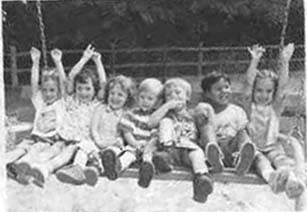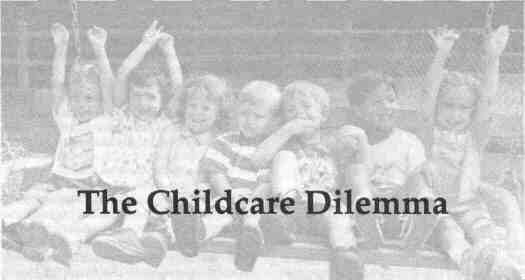Youth and Families
by Michael Kudla For those who grew up in the 1950s and 1960s, life was easy. Dad was a tradesman. On an electrician's salary, our family built a home in the suburbs, drove two cars and took vacations. My mother, like most mothers in the neighborhood, did not work. She cared for me and my two sisters all day and cooked a great meal every evening. Things were arranged the same way in just about every family in the neighborhood. Things have changed. The economics of middle class America necessitates two incomes to reach the same level of affluence as 30 years ago. Many mothers need to find self-fulfillment through a career or some activity outside the home. More than ever before families have two parents working outside the home. In many areas of the state, more than 50 percent of households have two working parents. In my community, Glencoe, the number is less than 38 percent. Childcare is becoming a central issue for many families. The anxiety experienced by a parent forced to leave a child all day is heightened by the uncertainty about the quality of care the child is receiving. Stories about poor childcare are well-documented. Some day care homes are unlicensed and unregulated. Profit-making day care centers can cut corners by spending less on staff and equipment to improve the bottom line. High quality private childcare centers are hard to find and often priced beyond the means of the average family. So, why should public parks and recreation agencies become involved in providing childcare? After all, we have invested a lot of time and energy improving the image of our field and making every attempt to lose the stigma that we are merely baby sitters. I believe that the parks and recreation philosophy should adjust for the times. We must broaden the scope of our services to meet the needs of our community. The field is changing. For example, the Glencoe Park District focuses heavily on early childhood development. That's where the demand is. Thus, the district employs more full-time personnel with degrees in education than recreation. At one time a recreation professional supervised Glencoe's growing preschool development program. We have found that parents and teachers demand program leadership from a professional trained in early childhood education. Earlier this decade, the field debated and discussed the philosophical issues surrounding the operation of childcare centers in Illinois Parks & Recreation magazine as well as educational sessions at state and national conferences. This year the debate resumes here in this article as well as at a session at the IAPD/IPRA Annual Conference in January. If the parks and recreation movement truly provides for the health and welfare of our society, I believe we should provide opportunities for childcare on a revenue-producing basis. With that said, the main body of this article takes a look at the Glencoe Park District's childcare center—in operation since 1987—and outlines keys to starting a successful childcare program and the many issues to consider. Glencoe's Childcare Center The Glencoe Park District's childcare center, "Children's Circle," opened in 1987 with classroom space in a wing of the district's 17-room community center. The initial program offerings and structure remains basically the same today with age groupings for toddlers, two-year-olds, three-year-olds, four-year-olds and kindergarten-age children. Center hours are 7:00 a.m. until 6:30 p.m. daily. The center is open all but five major holidays and two weeks (one summer and one Christmas holi- Illinois Parks & Recreation • July/August 1996 • 35
Within two years from its inception the center was filled to capacity with more than 85 children. To open the center, the childcare department borrowed $90,000 from the recreation fund to cover start-up costs, which included staff and equipment. (The facility already existed, so no construction costs were involved.) That $90,000 debt was paid back within two years. Glencoe's Children's Circle childcare center produces an annual profit of 15 percent of revenues. This is a very narrow profit margin. Most businesses operate on a higher percentage. The narrow margin doesn't leave much room for error or changes in the environment, such as recessionary times. A stand-alone day care center that is not receiving low-rate rent or free space, like a church, can't make it. Despite the risk of narrow margins, for Glencoe there was a real need in the community for childcare service. After a careful market study, it became clear that there would not be competition from other childcare centers. Glencoe's success can be explained by its management, which carefully watches all expenses, keeps salaries low (but slightly higher than the market rate), and runs a good program that enables the district to charge a little more for it. Glencoe has learned that its residents are willing to pay for quality. For any community, the program must be tailored for the residents. Similar yet distinct childcare programs are operated by park districts in Skokie, Dundee Township, Round Lake and Norridge and Carbondale. STEPS FOR SUCCESS Conduct a Market Study A solid market study is the first step to ensuring a new business will meet with success. Start with a simple but thorough survey that covers the following information: • demand for childcare in the area; • hours and days childcare is needed; • total numbers of children available for each age group (this can be computed easily using the survey data); • respondent's willingness to pay for childcare and how much the family can afford to spend; and • features desired, including learning programs, play equipment, flexible hours, hot lunches. And, remember to ask the most important question: Will they use the service if located at a particular site? Mail the survey to residents who live within a 10- to 15-minute drive from your prospective site. (People will rarely drive further than that with their child on a daily basis.) Research the Industry Study the industry pricing practices and marketing tactics. The quality of care directly relates to labor. Labor will have a large impact on the fees charged. The Department of Children and Family Services (DCFS) regulations dictate the teacher/child ratio in each classroom, and it is difficult to exceed this ratio and still keep the center profitable (see following section on DCFS). Survey area day care centers and develop a grid of their prices and features. Analyze the factors that will effect the success of the childcare center. Take the time to list the strengths, weaknesses, opportunities, and threats to the proposed center and the general environment of the community. For example, the Glencoe Park District had a growing half-day preschool program from which to build. This was a strength for the district. A weakness for any agency may be the heavy dependence on full enrollment to ensure financial success. A definite opportunity is the extensive positive public relations derived from operating a good childcare center. An obvious threat is the emergence of private childcare homes and nannies. Develop a Program Plan It's now time to develop a program plan or overall strategy for the center, outlining the age groups to be served, prices, hours and maximum number of enrollees. List major appeals of the center for later use in publicity pieces. Develop a general outline of the daily activities and child development programs. Finally, construct an advertising and promotional plan. Direct mail is the favorite choice of most park districts and is best suited for a new childcare program. Develop a special brochure for agency mailings. Send letters and brochures to real estate offices and the human resource departments of area businesses. Glencoe found businesses to be very cooperative in disseminating information. Childcare is such a problem for businesses that some will cooperate to help create facilities. I have been told more than once that Glencoe's childcare care center and preschool are the biggest features that prompt couples to buy a home in Glencoe. Work with DCFS It's very important to involve the State Department of Children and Family Services (DCFS) during the start-up process. 36 • Illinois Parks & Recreation • July/August 1996  According to state law, all full-day programs must be licensed
by DCFS. The licensing requirements of DCFS are lengthy and
it's good advice to read them in detail. Make notes and write
questions in the margins. Then meet with a DCFS representative
and take detailed notes of the interpretations offered by the
representative.
According to state law, all full-day programs must be licensed
by DCFS. The licensing requirements of DCFS are lengthy and
it's good advice to read them in detail. Make notes and write
questions in the margins. Then meet with a DCFS representative
and take detailed notes of the interpretations offered by the
representative.
If the proposed childcare facility is available for tour, take the representative through each room and take room measurements along the way. Classroom space requirements are one of the most important regulations and they tie-in to DCFS's teacher/child ratios, which are required to ensure safe supervision: 1 teacher per 4 infants, 1:5 for toddlers (15 mos.), 1:8 for two-year-olds, 1:10 for preschool and 1:20 for school-age children. If a classroom is large enough for only twelve toddlers, DCFS will still require three teaches. If the full maximum of fifteen children are enrolled, the class will be financially successful. Consider Personnel Factors Wages and salaries for childcare center personnel fall far below traditional park district pay structures. The industry salary standards are kept low to make the service feasible to participants. For example, a full-time teacher qualified with a bachelor's degree will start at $18,000 per year. While low for the park and recreation industry, it's a high starting salary for a childcare teacher. Full-time assistant teachers earn $7.50 per hour, but receive no holiday or vacation pay. All full-time staff at the day care center work one-half hour per day longer than the Parks Department, and Glencoe only recently added medical insurance to its benefits package. DAILY PROGRAM CONSIDERATIONS The daily program is the backbone of any childcare center. More and more parents are demanding a professionally developed curriculum of daily activities complete with developmental learning objectives. Following is a list of key program issues to consider. Building Security Parents will be skeptical if the center has unsupervised access doors to the outside. To ensure safety and ease parent's worries, Glencoe installed a key pad combination lock for parents to enter the childcare wing of the community center. Staff Turnover This is one of the most serious problems for childcare centers. A lack of continuity in a child's teacher can have a negative impact on his or her development. Staff/Child Ratios Follow the requirement ratios established by law through the DCFS. These ratios must be kept at all times. No excuses allowed. Program Philosophy Parents want to be assured that professional teachers are creating curriculum based on the latest and most widely accepted child development methods. Illness Policy Eventually all parents get frustrated when they must leave work to take home a sick child. Assure parents that a commonsense approach will be followed. If the child does not show obvious symptoms of illness, resting on a cot in the office may be all that is required. Make it clear, however, that severely ill children cannot return to the center without a letter from a pediatrician. Staff Background Checks Recently publicized cases of child abuse make criminal background checks and reference checks critical for all employees. Prepare a list of personnel background check procedures for parents. Health and Safety of the Children Show parents that cleaning chemicals, paints and crafts supplies are locked and used only under strict supervision. Boast about the response time of paramedics and keep first aid supplies in view and well-marked in each classroom. A full-time nurse is probably not affordable, but the DCFS requires a nurse to visit the center once each month to review records, inspect classrooms and instruct staff on diapering and hand-washing. Snack and Lunch Menu If the agency uses a caterer or hires a cook, be certain there is a licensed nutritionist on staff to ensure balanced meals. At Children's Center, a caterer is contracted for 96 cents per lunch. GLENCOE'S POSITIVE RESPONSE Opening a childcare center was like trying to fit a round peg in a square hole. There are so many problems that recreation administrators are unaccustomed to dealing with (i.e., high Illinois Parks & Recreation • July/August 1996 • 37 staff turnover, hours and days of operation, DCFS regulations). It took the Glencoe staff a few years to become comfortable operating the center. However, the rewards are well worth the effort. The childcare parents are the park district's strongest supporters, and, in these times of tax revolts, you can't find enough residents to support the park district's services. At Glencoe's Children's Circle childcare center, quotes like these are commonplace: "The center helps families with two working parents to function while our children are well cared for. The staff helps create a thoughtful, developmentally stimulating program." —parent of a kindergarten-age child "We love Children's Circle and everyone involved with the program. Thanks so much!" —parent of a toddler "I am very happy with the hot meals. My son eats better at school than at home. I hope that is not a reflection of my cooking!" —parent of a two-year-old Michael Kudla is the assistant director of recreation and facilities for the Glencoe Park District. He was instrumental in the development of Glencoe's Children's Circle and continues to manage the staff at the center. The photographs in this article were taken by Cheryl DeClerck, program manager for the Glencoe Park District. For more on childcare issues, attend the session "Day Care—Should Park Districts Do It?" at the IAPD/IPRA Annual Conference in January of 1997. 38 • Illinois Parks & Recreation • July/August 1996 |
||||||||||||||


 day) for vacations. Children's Circle provides hot lunches and
a professional lead teacher in each classroom. Program development
is a big part of the lead teachers job, and the classrooms are outfitted
with the latest play equipment and materials.
day) for vacations. Children's Circle provides hot lunches and
a professional lead teacher in each classroom. Program development
is a big part of the lead teachers job, and the classrooms are outfitted
with the latest play equipment and materials.